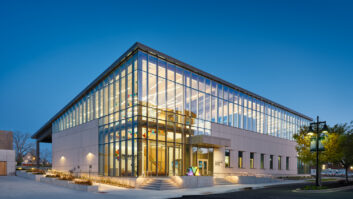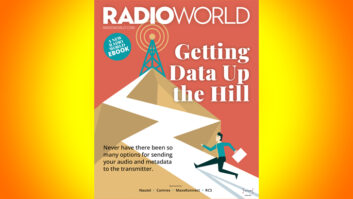
Looks like we’ll be hearing more discussion about changes to the main studio rule soon.
FCC Commissioner Michael O’Rielly spoke to a meeting of the Association of Federal Communications Consulting Engineers Friday. While speaking about recent AM revitalization efforts, he said that some important questions were left to a Further Notice of Proposed Rulemaking.
“For instance, I’d personally like to see us split off the relief for the main studio rule from the FNPRM so as to complete it before year’s end, and you are likely to hear more from me on this soon,” the Republican commissioner said.
At present a station’s main studio must be located within a station’s principal community contour, within the contour of any other broadcast station licensed to its community or within 25 miles of the center of its community. Last winter the National Association of Broadcasters told the FCC it supports relaxing main studio and staffing requirements. Separately the Multicultural Media, Telecom and Internet Council has called for the elimination of the main studio rule entirely, calling it a relic.
The commission has been pondering some kind of action in this area. In the fall of 2015 as it took AM revitalization steps, it also looked ahead at some possible further changes. It wrote then that despite advances in accessibility to broadcast stations and their personnel, “we are reluctant to eliminate main studio requirements entirely, because of the … importance of the main studio to the goal of ensuring station compliance with local service obligations.” But it asked then whether it should be more liberal with waivers and whether to explore ways of relaxing the rules.
At his Friday talk, O’Rielly also said that he is “carefully considering” the commission’s proposal to reduce the protected daytime primary service contour for certain AM stations. “And of course when doing so, the actual areas and levels of additional interference are of primary interest.”
He told the AFCCE engineers that their comments filed in the proceeding “succinctly and fully explain the differences between areas of contour overlap and areas of interference in a very helpful way.”
Ultimately, though, O’Rielly said that the future of AM radio “will be decided in the market by stations seeking to meet the demands of listeners, as it should be. No amount of commission action or government involvement is going to save the medium from irrelevancy if listeners and advertisers abandon stations, although I don’t see that happening in the immediate term. From my conversations with AM radio license holders, that’s exactly how they see it too: they just want the commission to eliminate some of the barriers to competition so they have the tools to win the hearts and minds of listeners and then let the chips fall where they may.”
He also spoke about ATSC transition and a proposal to eliminate or modify the cable signal leakage rules for companies that have deployed fiber in a given service area.
The full text of his remarks is below.
>>>
Remarks of Commissioner Michael O’Rielly
Luncheon Meeting of the Association of Federal Communications Consulting Engineers
September 16, 2016
Good afternoon and thank you so much for hosting me today, with a fine lunch as well. Discussions at the Commission often have the tendency to focus on rhetorical arguments, so I greatly appreciate this organization’s function of monitoring FCC technical policy to ensure that our regulations coincide as closely as possible with sound engineering principles. Your input on the many technical questions we encounter goes a long way toward keeping us on the right track. So thank you for all that you do to engage and contribute to so many proceedings at the Commission.
A great example is the Association’s comments in the AM Revitalization proceeding, which the Commission moved to a First Report and Order almost a year ago. After a lot of consternation, we were finally able to reach accord and provide many AM radio stations with new options to compete in the ever changing marketplace. As you know, the Order provided multiple windows for AM broadcasters to relocate FM translator stations in order to rebroadcast AM signals, and many of the broadcasters have been taking advantage of the opportunity. Meanwhile, some important questions were left to a Further Notice, which you have weighed in on. For instance, I’d personally like to see us split off the relief for the main studio rule from the FNPRM so as to complete it before year’s end, and you are likely to hear more from me on this soon. In addition, I am carefully considering the Commission’s proposal to reduce the protected daytime primary service contour for certain AM stations, and of course when doing so, the actual areas and levels of additional interference are of primary interest. Your comments succinctly and fully explain the differences between areas of contour overlap and areas of interference in a very helpful way.
At the end of the day, however, the ultimate future of AM radio will be decided in the market by stations seeking to meet the demands of listeners, as it should be. No amount of Commission action or government involvement is going to save the medium from irrelevancy if listeners and advertisers abandon stations, although I don’t see that happening in the immediate term. From my conversations with AM radio license holders, that’s exactly how they see it too: they just want the Commission to eliminate some of the barriers to competition so they have the tools to win the hearts and minds of listeners and then let the chips fall where they may.
Most recently, the Association filed comments in the ATSC 3.0 proceeding, which I read with great interest. As you noted, the Next Generation TV enabled by the new standard would offer an opportunity to transform over-the-air broadcast television in a number of ways. It must be exciting for many of you to be on the front lines of the latest revolution in broadcasting. And it is reassuring to hear that the Association does not expect ATSC 3.0 to increase interference potential over the ATSC 1 standard – in fact, if your information is accurate, it seems that interference could be reduced in some instances.
Providing those interested broadcasters with the opportunity to move to this new platform could be a game changer for the viewer and the broadcasting business. You know better than I do, but we are talking about a totally flexible structure capable of allowing broadcasters to tailor their transmissions to meet their particular market dynamics. It will permit a range of features from fully mobile offerings to 4K Ultra-High Definition with visual qualities of high-dynamic range and a superior audio experience. I’ve seen the demonstrations of the new standard, or more correctly set of standards, and as a consumer, I am excited about its possibilities. For those broadcasters not interested, the proposal accommodates their desire to stand pat.
I realize that there is a long way to go to finalize the entire portfolio of standards that will make up the umbrella ATSC 3.0. In fact, the physical layer was approved by ATSC just last week. No one should underestimate the importance of this step, but there are still upwards of twenty other components subject to separate standard approval to be completed. It’s not unlike building a new skyscraper. The key is a solid foundation and first couple of floors and then construction can get easier from there. So, everyone should be pleased with where the 3.0 standard is at this point in time, but there is much work ahead, and no one should take their eye off the ball.
Your comments to the Commission also raised an interesting point that dovetails well with my own focus in considering ATSC 3.0. Namely, you noted that, “[w]ithout regulatory permission, wireless companies have long been able to periodically upgrade their transmission technologies to realize improved efficiencies and implement new services, but television broadcasters have been locked into a technology that is two-decades old.”
This is a critical observation, and I wholeheartedly agree that the imbalance needs to be corrected. For my purposes at the FCC, this means I am suggesting that the Commission not seek to just approve the new standard as it did twenty years ago with ATSC 1.0. Instead, I suggest that our rules be rewritten to permit broadcasters to offer 3.0. There is a difference between these approaches and some have critiqued my approach as not being exactly in line with what the petition before the Commission is requesting. From my view, the Commission’s primary goal should be to encourage and enable innovation now and in the future. We should avoid any tech mandates or overly prescriptive measures, taking instead a flexible approach that allows for experimentation by the industry in pursuit of voluntary, consensus-driven solutions. As I have said, we should also take this opportunity to open the door as much as possible to future permissionless innovation of the type that has spurred such rapid development in the wireless world. Let’s overhaul existing rules to make sure that the next broadcast standard will never be stuck in this game of “FCC, May I?” Since both adopting the new standard and removing barriers to allow flexibility and choice of technologies get to the same end point, why not pursue the one that sets the stage for ATSC 4.0 or 5.0?
Relatedly, it should not be overlooked that the new standard’s lack of backward compatibility will create some challenges in meeting the goal of minimizing consumer disruption. Ideally, these will be addressed by industry participants. Some of you may already be involved in the development of new equipment for broadcasters or consumers, either to take advantage of the new standard or to convert the programming for viewing on older devices. I view the FCC’s role in this process as that of a facilitator, not a controller. Hopefully political agendas can be left on the sidelines as creative solutions emerge.
So those are a few of the principles guiding my approach to the ATSC transition. As to the timing, this Association and many others are requesting expedited consideration. Certainly your finding that there is no technical reason for delay should raise my colleagues’ confidence in moving forward. Ultimately, however, I am not in control of the timing. In fact, this may be hard for you to believe, but I am pretty far outside of the loop when it comes to setting the Commission’s agenda. However, you do have my commitment to remain fully engaged on this issue and responsive to any concerns or further thoughts you may have as we move forward.
On another note, this morning I published a blog post on a new issue that might be of interest to Association members. It’s an idea that has come up in my conversations with broadband and video network operators in rural parts of America. They suggested that the Commission look into eliminating or modifying the cable signal leakage rules for companies that have deployed fiber in a given service area.
These rules are meant to address the radio frequency leaks that can occur in traditional coaxial cable networks for a number of reasons, such as loose connections, damaged plant, or cracked cables. RF leaks from these systems can generate harmful interference to nearby spectrum users, such as aeronautical and navigation systems. Many of you may be familiar with the Commission’s requirements that cable system operators regularly monitor for potential signal leakage, and test annually to ensure that total system leakage is below the acceptable maximum levels. But as cable operators gradually go about the task of upgrading coax to fiber, an upgrade the Commission should be doing its best to encourage and incentivize, the obsolete signal leakage rules apply to the new fiber. This makes absolutely no sense given that with most fiber deployed there is no RF being used and therefore no RF interference.
The impact in the scheme of things might not sound earth shattering, but can quickly become significant. In order to conduct the RF testing, small providers rent a small plane and circle their territory with appropriate RF sensors to measure potential leakage. The cost is around $5000, barely a blip on the screen in Washington-speak, but this cost multiplies into much different numbers when you operate multiple small systems. One operator is spending upwards of $100,000 a year when time and labor are factored in, a shameful waste of precious rural communications resources when testing fiber systems for leakage that we all know is not there.
The Commission did look at this issue before as part of another, larger proceeding, but that proceeding stalled out due to substantial concerns raised regarding other proposals that were made. Just to be clear, I am not looking to reopen the discussions on these other proposals by any means, but the update to cable signal leakage rules is a good idea that could and should be separated and expedited. Systems in which an extensive amount of fiber is used should not be subjected to Commission rules that were adopted for another very different technology.
The Commission could easily and quickly fix this problem, relieving one small and unnecessary burden, through a rule change, declaratory ruling, or waiver. It seems to me a reasonable minor step we should be able to make without much controversy. I would welcome any reactions or suggestions any of you individually, or the Association may have. And of course I would more than welcome your support as I try to move the effort forward!
I am also interested in any other ideas you may have to modernize our rules and make it just a little bit easier for American innovators to keep bringing us the small miracles that the tech and telecom industries produce every day. Given my previous remarks about my potential to impact the Commission agenda, the big ticket items are likely nonstarters, but I can and often do find common ground to get a common sense idea moving. So, I am all ears if you have one.







